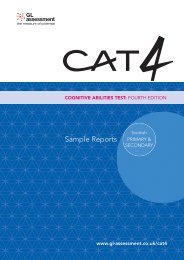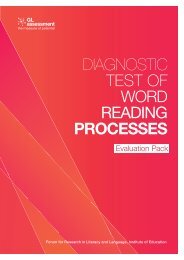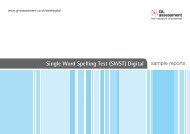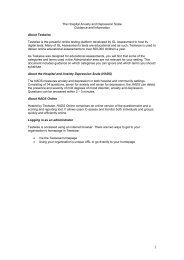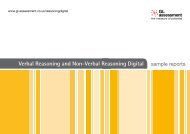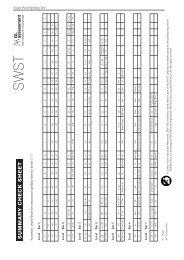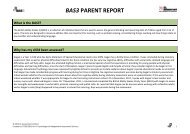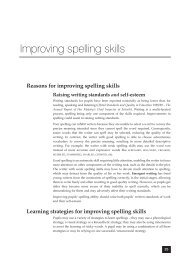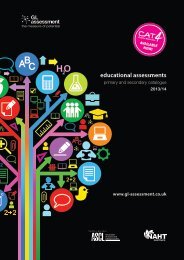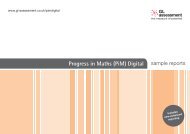Progress in English 11-14 and National Curriculum English levels
Progress in English 11-14 Performance Indicators - GL Assessment
Progress in English 11-14 Performance Indicators - GL Assessment
- No tags were found...
You also want an ePaper? Increase the reach of your titles
YUMPU automatically turns print PDFs into web optimized ePapers that Google loves.
Table 2: Estimates of end of KS3 test <strong>levels</strong> <strong>in</strong> <strong>English</strong> from PiE <strong>11</strong>-<strong>14</strong> st<strong>and</strong>ardised<br />
scores<br />
PiE<br />
Probability of achiev<strong>in</strong>g each NC level<br />
St<strong>and</strong>ardised<br />
Score<br />
3 or<br />
below 4 5 6 7 8<br />
Indicated<br />
level<br />
74 or below 65% 30% 5% 3 or below<br />
75-79 43% 44% 12% 1% 4C<br />
80-84 25% 50% 23% 2%<br />
85-89 13% 44% 37% 4%<br />
90-94 7% 33% 51% 9% 1%<br />
95-99 4% 21% 58% 16% 2%<br />
100-104 2% 13% 57% 26% 3%<br />
105-109 1% 7% 49% 37% 5% 1%<br />
<strong>11</strong>0-<strong>11</strong>4 1% 4% 38% 48% 9% 1%<br />
<strong>11</strong>5-<strong>11</strong>9 3% 28% 54% <strong>14</strong>% 2%<br />
120-124 2% 20% 56% 20% 2%<br />
124+ 1% <strong>14</strong>% 54% 27% 4%<br />
Note: All figures are rounded to whole numbers <strong>and</strong> may not sum to 100%. Blank cells <strong>in</strong>dicate the presence of fewer than<br />
0.5% of pupils. The <strong>in</strong>dicated <strong>levels</strong> are based on the KS3 test <strong>levels</strong> but have been subdivided <strong>in</strong>to categories A, B or C<br />
with A denot<strong>in</strong>g a higher level than B or C.<br />
Us<strong>in</strong>g the tables <strong>and</strong> charts<br />
To use the table for a particular pupil, you should f<strong>in</strong>d the appropriate score b<strong>and</strong> <strong>in</strong> the first<br />
column with<strong>in</strong> which the pupil’s score lies. You should then read off the percentages <strong>in</strong> the<br />
adjacent columns along the same row. The middle six columns give an <strong>in</strong>dication of the<br />
likelihood of achiev<strong>in</strong>g each KS3 test level. The last column gives an <strong>in</strong>dication of the level<br />
the pupil is most likely to obta<strong>in</strong>, based on the probabilities of obta<strong>in</strong><strong>in</strong>g each level.<br />
For example, a pupil with a st<strong>and</strong>ardised PiE score of 88 has a 13% chance of obta<strong>in</strong><strong>in</strong>g a<br />
level 3 or below, a 44% chance of obta<strong>in</strong><strong>in</strong>g a level 4, a 37% chance of obta<strong>in</strong><strong>in</strong>g a level 5<br />
<strong>and</strong> a 4% chance of obta<strong>in</strong><strong>in</strong>g a level 6. However, the most likely outcome for the pupil is<br />
level 4A.<br />
Sett<strong>in</strong>g targets<br />
The table shows what pupils with different PiE scores actually achieved <strong>in</strong> the KS3 tests.<br />
PiE scores can therefore be helpful <strong>in</strong> provid<strong>in</strong>g forecasts for pupils’ atta<strong>in</strong>ment at the end of<br />
KS3. However, targets are more than forecasts, s<strong>in</strong>ce targets should also <strong>in</strong>clude an<br />
element of challenge. Your wide <strong>and</strong> detailed knowledge of each <strong>in</strong>dividual pupil, <strong>and</strong> your<br />
class/school aspirations <strong>in</strong> relation to the benchmark tables conta<strong>in</strong>ed <strong>in</strong> the Autumn<br />
Package <strong>and</strong> other data, will contribute to translat<strong>in</strong>g these forecasts <strong>in</strong>to challeng<strong>in</strong>g yet<br />
achievable targets.<br />
Updat<strong>in</strong>g the <strong>in</strong>dicators<br />
You can download updated <strong>in</strong>dicators <strong>and</strong> full technical reports from our website at www.glassessment.co.uk.<br />
If you have any queries please call the GL Assessment Customer<br />
Services Team on 0845 602 1937. To discuss any tra<strong>in</strong><strong>in</strong>g requirements you may have <strong>in</strong><br />
underst<strong>and</strong><strong>in</strong>g st<strong>and</strong>ardised assessments, please contact GL Performance’s Cont<strong>in</strong>u<strong>in</strong>g<br />
Professional Development on (020) 8996 6039.



